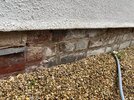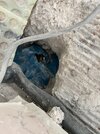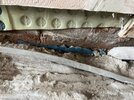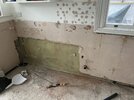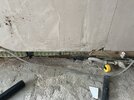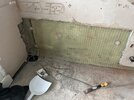Hi All,
I'm installing a new kitchen and will be self levelling the concrete slab for tiling (TBD). I've just discovered that the DPC is a course too high and actually sits above the concrete slab. Weirdly the cowboys who did the kitchen previously have also cut away the DPM at the level of the floor. I now intend on using Dry-rod along the correct course of bricks this will be 2 courses high and below the interior floor. So just a few questions if I may..
1. Is it possible or necessary to do anything about the DPM at the edges, its my house but I'm very tight on time and I'd prefer a simple solution?
2. Assuming the dry-rod is the right way to go? again, time will not allow me to get someone in for a physical DPC.
3. Say this was the cause of having a slightly damp concrete slab, as it will be rectified, can I now just lay a single self leveller, without the liquid DPM? Or is it best to assume any 'drying' will take months? (we did have an industrial dehumidifier and fans for 3 weeks straight, after the leak.)
4. We had a leak and the insurance coy lifted a corner of concrete and damaged the DPM at the same time. Worth noting that the dust and concrete feel bone dry but under the DPM it is damp. How best and simplest way of fixing this?
Worth mentioning that I've laid a cheap digital hygrometer underneath a plastic sheet, sealed on all 4 sides. It's been there for 36 hours unto now and the hygrometer has only risen by 1% (to 35%). I understand this isn't a perfect test by any stretch, but thought it maybe useful to know. Also, the plastic tanking comes to the floor, is this normal?
Also worth saying that we had tiles previously which were an absolute nightmare to get up and there was only signs of a damp area where we'd had the leak. Also, I'll only be laying the tiles to the plinth, not all the way under.
I've attached pics which I hope will help. I've only 5 days to finish the whole job, so your advice is very much appreciate, as always!
Thanks again,

I'm installing a new kitchen and will be self levelling the concrete slab for tiling (TBD). I've just discovered that the DPC is a course too high and actually sits above the concrete slab. Weirdly the cowboys who did the kitchen previously have also cut away the DPM at the level of the floor. I now intend on using Dry-rod along the correct course of bricks this will be 2 courses high and below the interior floor. So just a few questions if I may..
1. Is it possible or necessary to do anything about the DPM at the edges, its my house but I'm very tight on time and I'd prefer a simple solution?
2. Assuming the dry-rod is the right way to go? again, time will not allow me to get someone in for a physical DPC.
3. Say this was the cause of having a slightly damp concrete slab, as it will be rectified, can I now just lay a single self leveller, without the liquid DPM? Or is it best to assume any 'drying' will take months? (we did have an industrial dehumidifier and fans for 3 weeks straight, after the leak.)
4. We had a leak and the insurance coy lifted a corner of concrete and damaged the DPM at the same time. Worth noting that the dust and concrete feel bone dry but under the DPM it is damp. How best and simplest way of fixing this?
Worth mentioning that I've laid a cheap digital hygrometer underneath a plastic sheet, sealed on all 4 sides. It's been there for 36 hours unto now and the hygrometer has only risen by 1% (to 35%). I understand this isn't a perfect test by any stretch, but thought it maybe useful to know. Also, the plastic tanking comes to the floor, is this normal?
Also worth saying that we had tiles previously which were an absolute nightmare to get up and there was only signs of a damp area where we'd had the leak. Also, I'll only be laying the tiles to the plinth, not all the way under.
I've attached pics which I hope will help. I've only 5 days to finish the whole job, so your advice is very much appreciate, as always!
Thanks again,


